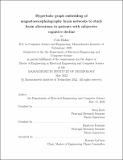Hyperbolic graph embedding of magnetoencephalography brain networks to study brain alterations in patients with subjective cognitive decline
Author(s)
Baker, Cole
DownloadThesis PDF (1.378Mb)
Advisor
Katz, Boris
Pantazis, Dimitrios
Terms of use
Metadata
Show full item recordAbstract
Identifying subtle changes in brain activity in the early stages of pathology is crucial for gaining understanding of the causes and mechanisms of neurodegenerative diseases such as Alzheimer’s disease (AD). Mapping high dimensional brain connectivity information to a lower dimensional latent space can allow quantitative analysis of the subtle changes in brain activity and create information-rich inputs to downstream classification tasks. Using a Hyperbolic Graph Convolutional Network (HGCN), we embed functional brain connectivity graphs derived from magnetoencephalography data to a Poincare disk instead of traditional Euclidean space. The Poincare disk is a negatively curved unit disk that encourages a continuous tree-like (and low-dimensional) embedding where paths between sibling nodes pass through a more central parent node. This model allows scale-free graphs to be embedded into 2 dimensions with low distortion while maintaining a conformal mapping of angles to Euclidean space. The Poincare model is particularly useful for neuroscientific analysis, as brain networks are generally scale-free, and the low dimensional mappings can facilitate learning despite the typically small datasets that are available in the field. The embeddings provide a parsimonious description of both similarity and hierarchy, which can be used to study the role of individual brain regions and known functional subnetworks, such as the default mode network (DMN) and ventral attention network (VAN). We used the hyperbolic embeddings to assess MEG brain network alterations in subjects with Subjective Cognitive Decline, a pre-clinical precursor to AD in which the subject cannot be objectively diagnosed through traditional neuropsychological testing. Poincare embeddings were used to classify subjects’ disease state and identify functional changes in the interconnectivity of several subnetworks as well as the overall hierarchical placement of those networks.
Date issued
2022-05Department
Massachusetts Institute of Technology. Department of Electrical Engineering and Computer SciencePublisher
Massachusetts Institute of Technology